2.9: Trigonometric Functions
( \newcommand{\kernel}{\mathrm{null}\,}\)
- Identify the hypotenuse, adjacent side, and opposite side of an acute angle in a right triangle.
- Determine the three trigonometric ratios for a given angle in a right triangle.
- Use a calculator to find the value of the three trigonometric functions for any acute angle.
- Use a calculator to find the measure of an angle given the value of a trigonometric function.
Introduction
Suppose you want to build a ramp for access to a loading dock that is 4 feet above ground level. You want to be able to easily push a cart on wheels up the ramp, and the angle of elevation should be no more than 20∘. How long does the ramp have to be?
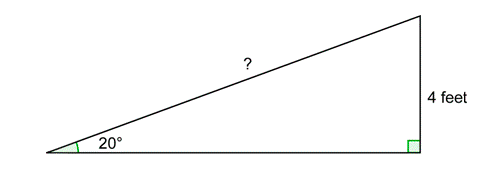
In this diagram, you have a right triangle for which you know the length of one side and the measure of an acute angle. You want to find the length of the hypotenuse. You may know that the Pythagorean Theorem enables you to find the length of one side of a right triangle, given the lengths of the other two sides. Now you will learn trigonometry, which is a branch of mathematics that studies the relationship between angles and the sides of triangles. In fact, trigonometry will allow you to find unknown side lengths and angle measures in right triangles in a variety of cases, such as in the problem above.
The Sides of a Right Triangle
In the example above, one of the acute angles has a measure of 20∘. You could describe the side (or leg of the right triangle) with length 4 feet as the height of the triangle, or you could say that it is “opposite” the 20∘ angle. The other leg is said to be “adjacent” to the 20∘ angle. In trigonometry, this type of relationship between sides and angles is very important.
The general relationship between sides and angles is shown in the diagram below.
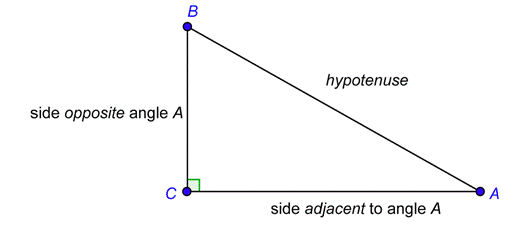
Angle A is formed by the hypotenuse and leg ¯CA. We say that leg ¯CA is the side adjacent to angle A. We say that leg ¯BC is the side opposite angle A. In other words, the adjacent side is the leg that is part of the angle; the opposite side is the leg that is not part of the angle.
Problem: What is the length of the side opposite angle X and the length of the side adjacent to angle X?
Answer
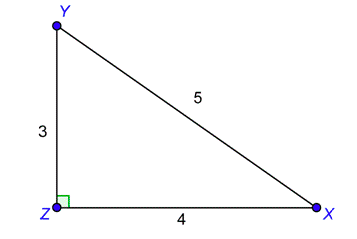
The side opposite angle X is ¯YZ. Its length is 3. The side adjacent to angle X is ¯ZX. Its length is 4.
opposite side length: 3
adjacent side length: 4
Keep in mind that the labels “opposite” and “adjacent” depend on which angle you are talking about. The side opposite an angle does not need to be the height of the triangle. Consider the following example:
Problem: What is the name of the side opposite the 40∘ angle and the name of the side adjacent to the 40∘ angle?
Answer
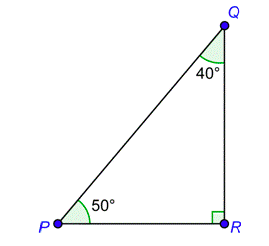
The 40∘ angle is formed by the hypotenuse and ¯QR, so ¯QR is the adjacent side. Since ¯PR is not a part of the 40∘ angle, it is the opposite side.
opposite side: ¯PR
adjacent side: ¯QR
Each leg in a right triangle is adjacent to one of the acute angles and opposite the other acute angle.
Problem: In △AB, side ¯DA is adjacent to which angle and opposite which angle?
Answer
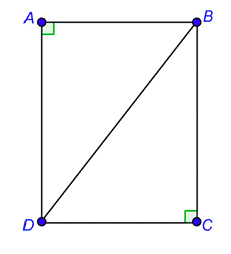
Side ¯DA and the hypotenuse ¯DB together form ∠ADB. So ¯DA is adjacent to ∠ADB. Since ¯DA is not part of acute angle ∠ABD, ¯DA is the side opposite ∠ABD.
adjacent to ∠ADB
opposite ∠ABD
The Three Primary Trigonometric Ratios
Suppose your professor asks you and another student to draw a triangle with angle measures 35∘, 55∘, and 90∘. You and your friend will probably draw triangles of different sizes. However, because the triangles will have the same angle measures, they will be similar.
Remember that this means that the triangles will have proportional corresponding sides. For example, one triangle might have sides that are all twice as long as the sides of the other, as seen below.
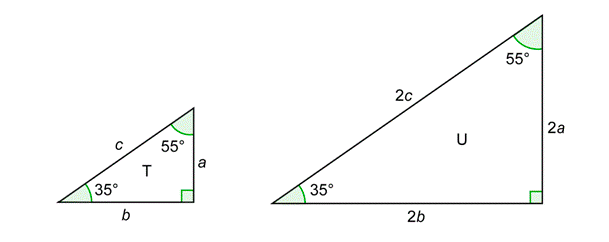
Now suppose that each of you has been asked to find the ratio of the side opposite the 35∘ angle over the hypotenuse. Even though you are using different triangles and will have different numbers in the numerator and denominator, you will still end up with the same result. The two of you will get:
opposite 35∘ in T hypotenuse of T=ac and opposite 35∘ in U hypotenuse of U=2a2c=ac
The two ratios are the same because the 2s cancel. If you draw a triangle with the same angles and sides that are three times as long as those of triangle T, the ratio of the side opposite 35∘ over the hypotenuse will be 3a3c=ac. This ratio will be the same for all similar triangles, and this ratio is called the sine of 35∘. Sine is abbreviated as sin35∘.
The same type of result will happen if you use other ratios of sides. For example, if you take the ratio of the side adjacent to 35∘ over the hypotenuse, you will get bc no matter which of the above triangles you use.
In addition to the sine ratio, there are other ratios that you can compute, such as cos, and tan. Just as sin is an abbreviation for sine, cos is short for cosine, and tan is short for tangent. (When reading these abbreviations aloud, you need to say the complete word.) These ratios will help you find unknown side lengths and unknown angle measures in right triangles. Let’s look at definitions for these ratios, starting with a typical right triangle like the one below.
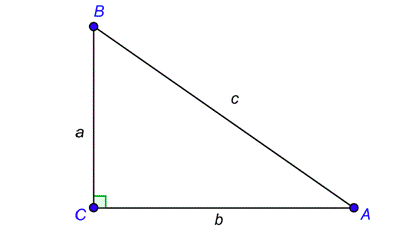
The definitions are as follows:
sinA= opposite hypotenuse =accosA= adjacent hypotenuse =bctanA= opposite adjacent =ab
Given these definitions, let’s practice applying them.
Problem: Determine the three primary trigonometric ratios for angle D in the right triangle below.
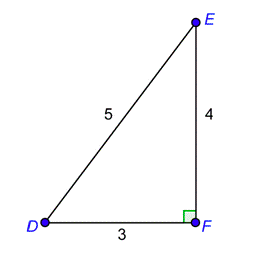
Answers
The first thing you need to do is recognize that ¯EF is opposite angle D and ¯DF is adjacent to angle D. Then write down their lengths.
length of side opposite D = 4
length of side adjacent to D = 3
length of hypotenuse = 5
Substitute these values into the definitions for the six ratios.
sinD= opposite hypotenuse =45cosD= adjacent hypotenuse =35tanD= opposite adjacent =43
sinD=45, cosD=35, tanD=43
Notice that the values of sine and cosine are between 0 and 1. You found them by dividing the length of a leg by the hypotenuse. The hypotenuse is the longest side, so the numerator is less than the denominator. That means the output of the sine or cosine function is always less than 1.
Keep in mind that the opposite side for one acute angle is the adjacent side of the other acute angle. In the example above, side EF was the opposite side for angle D. But, as you’ll see in the next example, it will be the adjacent side for angle E.
Problem: Determine the trigonometric ratios for angle E in the right triangle below.
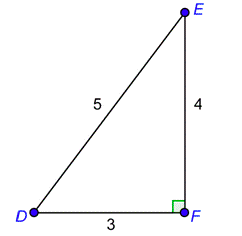
Answer
This is the same triangle that you saw in the previous example, so the hypotenuse is the same. The difference is that you are looking at the triangle from the perspective of angle E instead of angle D. So the opposite and adjacent sides switch places. That is, ¯EF is adjacent to angle E and ¯DF is opposite to angle E.
length of side opposite E = 3
length of side adjacent to E = 4
length of hypotenuse = 5
Substitute the new values into the definitions for the six ratios.
sinE= opposite hypotenuse =35cosE= adjacent hypotenuse =45tanE= opposite adjacent =34
sinE=35, cosE=45, tanE=34
What are the values of cosU and sinU?

- cosU=√53 and sinU=23
- cosU=32 and sinU=3√5
- cosU=23 and sinU=√53
- cosU=3√5 and sinU=32
- Answer
-
- cosU=√53 and sinU=23. Incorrect. You probably used the acute angle W, and found cosW and sinW. Remember that you get different ratios for the two acute angles, so pay careful attention to which angle you are using. The correct answer is C.
- cosU=32 and sinU=3√5. Incorrect. You may have used the acute angle W and also switched cosine and sine. Remember that you get different ratios for the two acute angles, so pay careful attention to which angle you are using. The correct answer is C.
- cosU=23 and sinU=√53. Correct. Using the definition of cosine, cosU= adjacent hypotenuse =23. Using the definition of sine, sinU= opposite hypotenuse =√53.
- cosU=3√5 and sinU=32. Incorrect. It looks like you switched the values of cosine and sine. The names are very similar, so be careful to use the right definition. The correct answer is C.
Relationships Among the Trigonometric Functions
The six ratios or functions are usually thought of as two groups of three functions. The first group is:
sinA= opposite hypotenuse =oh,cosA= adjacent hypotenuse =ah,tanA= opposite adjacent =oa
One way to remember these three definitions is with a memory device that uses the first letter of each word. The definition of sine is represented by soh (sine equals opposite over hypotenuse). Likewise, the definition of cosine is represented by cah (cosine equals adjacent over hypotenuse), and the definition of tangent is represented by toa (tangent equals opposite over adjacent). Putting these together gives you sohcahtoa.
The value of any trigonometric function is a ratio, or a fraction. Remember that fractions can be reduced.
Problem: For acute angle A, cosA=3√13 and tanA=46. Find the value of sinA.
Answer
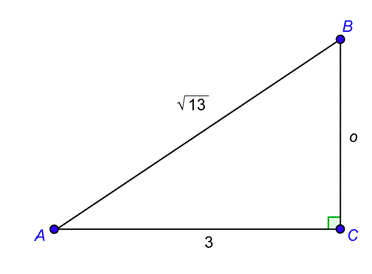
You want a right triangle where the ratio of the side adjacent to angle A over the hypotenuse is 3√13. A triangle with sides a=3 and h=√13 would have this ratio.
You can use the definition of tangent to find the opposite side. Substitute the value you are given for tangent and then solve the equation.
tanA= opposite adjacent =o346=o3126=o2=o
Now you have all three sides. Use the definition of sine to find its value.
sinA=oh=2√13
Remember that the sides of a right triangle satisfy the Pythagorean Theorem. So if a and b are the lengths of the legs, and c is the hypotenuse, you must have a2+b2=c2. In the last example, the lengths of the legs were 2 and 3, and the hypotenuse was √13, and it is true that 22+32=√132.
Using a Calculator to Find the Values of Trigonometric Functions
You know that if you draw similar triangles with angle measures 35∘, 55∘,and 90∘, the ratio of the side opposite 35∘ to the hypotenuse will be the same for all those triangles. This is sin35∘. The easiest way to find what this ratio actually equals is with a scientific or graphing calculator.
Looking at a calculator, you will find a key that says SIN on it. You can use this to find the value of sin35∘. Keep this in mind: you need to know that there are different units for measuring angles. For our purposes, make sure that your calculator is set in the “degree mode.” (The following instructions are generalized, but you may need to refer to your calculator’s instruction manual for how to perform these calculations on your particular calculator.)
If you use a scientific calculator, look in the display and see if it says DEG in small letters above the 0 (as opposed to RAD or GRAD). If it does not, press the DRG key until the display says DEG. Now enter 35, and then press the SIN key. The result is sin35∘:
sin35∘=0.573576436
If you have a graphing calculator, press the MODE key. The third line of the display will say RADIAN DEGREE. Use the arrows to select DEGREE, then press ENTER, 2ND, QUIT. Now the calculator is in degree mode. On a graphing calculator, you enter things the same way as you would write them. So press the keys to give you sin(35) on the display and then press ENTER. You should now see the value on the next line of the display.
Because sine is a function, given an angle measure X (the input), your calculator will give you the value of sinX (the output). All the right triangles with acute angle measure X will be similar, so the ratio of the opposite side to the hypotenuse will be the same for all of those triangles. Therefore, the ratio depends only on the value of X; it does not depend on the triangle.
Likewise, the other trigonometric ratios are functions. You can use your calculator to find the value of those functions. You will notice that next to the SIN key there are COS and TAN keys, which can be used to find the values of cosine and tangent.
Problem: Use your calculator to find the values of cos35∘ and tan35∘ to the nearest thousandth.
Answer
On a scientific calculator, enter 35, then press COS. Do this in the reverse order for a graphing calculator.
cos35∘=0.819152044
Remember to look at the ten thousandths place to help you round to the nearest thousandth.
cos35∘≈0.819
Use the same procedure for tangent.
tan35∘=0.700207538≈0.700
cos35∘≈0.819 and tan35∘≈0.700
Using a Calculator to Find Angle Measures
So far you have learned the definitions of the trigonometric functions. Remember that a function has an input and an output. For each of these functions, the input is the angle measure and the output equals a certain ratio of sides. Your calculator can be used to find the values of these functions. For example, if the angle measures 60∘, the cosine of the angle is 0.5. This can be represented as cos60∘=0.5.
Now what if the situation were reversed? What if you knew the value of the ratio and wanted to know the angle that produced it? That is, what if you knew the output of a trigonometric function, and wanted to know the input? For example, you might know that the cosine of some angle is 0.5 and want to find out what the angle is. You can use your calculator to find these values, too.
In general, when you reverse the input and the output of a function, what you get is called an inverse function. Your calculator can find the inverses of sine, cosine, and tangent. In the example above, on a scientific calculator you would enter 0.5, press the 2ND key, then press COS. The display would show 60. (Make sure that your calculator is set on degrees!) This tells you that the angle is 60∘. On a graphing calculator, you would press 2ND, then COS, then 0.5, and finally ENTER. (Keep in mind that you may need to refer to your calculator’s instruction manual for how to perform these calculations on your particular calculator.)
Above the SIN, COS, and TAN keys you will see sin−1,cos−1 and tan−1. These are the inverse trigonometric functions, and the way to read them out loud is: arcsine, arccosine, and arctangent. The result mentioned above can be written as cos−10.5=60∘ or arccos0.5=60∘.
If you were given the value of the sine (or tangent) function and wanted to know what angle produced it, you would follow a procedure similar to that described above. So on a scientific calculator, you would enter the value, press the 2ND key, then press SIN (or TAN).
Problem: Use your calculator to find the angle, to the nearest degree, whose tangent value is 0.75.
Answer
On a scientific calculator, enter 0.75, then press the 2ND key and TAN. Do this in the reverse order for a graphing calculator.
tan−10.75=36.86989765∘
Look at the tenths place to help you round to the nearest degree.
36.86989765∘≈37∘
tan−10.75≈37∘
If you are given the expression cos−10.24, for example, you can interpret this as saying, “Find the angle whose cosine equals 0.24.”
Problem: Determine cos−10.24 to the nearest tenth of a degree.
Answer
On a scientific calculator, enter 0.24, then press the 2ND key and COS. Do this in the reverse order for a graphing calculator.
cos−10.24=76.11345964∘
Look at the hundredths place to help you round to the nearest tenth.
76.11345964∘≈76.1∘
Remember that this means cos76.1∘≈0.24.
cos−10.24≈76.1∘
Here is a real-world example using an inverse function.
Problem: A skateboard ramp is 7 feet long with one end on the ground and the other end 2 feet above the ground. What is the angle of elevation to the nearest tenth of a degree?
Answer
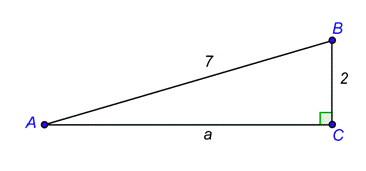
The angle of elevation is angle A. Because you know the opposite side and the hypotenuse, you can use the sine function.
Use the definition of sine. The unknown is the input.
sinA=27
You can rewrite this equation using arcsine. You need to reverse the input and the output.
A=sin−1(27)
On a scientific calculator, divide 2 by 7, then press the 2ND key and SIN. Do this in the reverse order for a graphing calculator.
A=sin−10.285714286=16.6015496∘≈16.6∘
16.6∘
Remember that the sine or cosine function cannot have an output greater than 1. With arcsine and arccosine, you are reversing inputs and outputs. Consequently, the input of these functions cannot be a number bigger than 1. If you try to compute sin−12 with your calculator, for example, you will get an error message.
If sinx=13, what is x to the nearest hundredth of a degree?
- 0.01∘
- 0.34∘
- 19.47∘
- 70.53∘
- Answer
-
- 0.01∘. Incorrect. Instead of finding sin−1(13), you found sin(13). The correct answer is 19.47∘.
- 0.34∘. Incorrect. You did not have your calculator set on degrees. Before doing any calculations, make sure that you first have it set on degrees. The correct answer is 19.47∘.
- 19.47∘. Correct. The solution to the equation is given by computing sin−1(13).
- 70.53∘. Incorrect. Instead of finding sin−1(13), you found cos−1(13). The correct answer is 19.47∘.
Summary
The six trigonometric functions are defined as ratios of sides in a right triangle. Their values depend only on the angle and not on any particular right triangle. A good way to remember the definitions of sine, cosine, and tangent is with the memory device sohcahtoa. The other three functions, cosecant, secant, and cotangent, are reciprocals of the first three.
You can use a calculator to find the values of these functions or ratios. You can also use a calculator to find the values of the inverse trigonometric functions. That is, given the ratio, you can find the angle that produced it.


